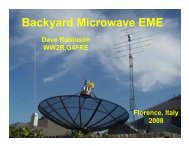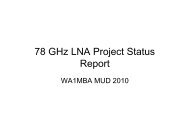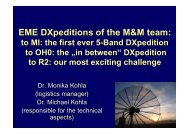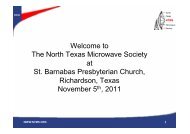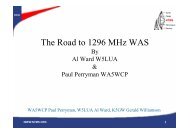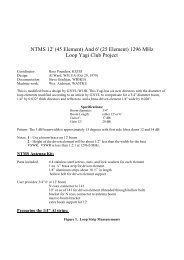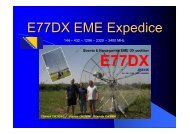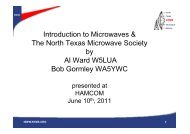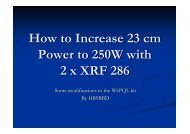The N1JEZ Simple GPS Stabilized 10 MHz Oscillator - NTMS
The N1JEZ Simple GPS Stabilized 10 MHz Oscillator - NTMS
The N1JEZ Simple GPS Stabilized 10 MHz Oscillator - NTMS
- No tags were found...
Create successful ePaper yourself
Turn your PDF publications into a flip-book with our unique Google optimized e-Paper software.
W5HN<strong>The</strong> problemNorthTexas<strong>NTMS</strong>MicrowaveSociety• WA5TKU has told us how to ensureantenna alignment when roving, so whatother variables can prevent a QSO?2
W5HNSolutionsNorthTexas<strong>NTMS</strong>MicrowaveSociety• Use a rubidium standard• HP Z3801 <strong>10</strong><strong>MHz</strong> <strong>GPS</strong> locked referenceis a solution but is costly and bulky• G3RUH and G4JNT have producedsolutions using <strong>10</strong>kHz outputs from <strong>GPS</strong>boards (not 1PPS)• I used cheaper, smaller <strong>N1JEZ</strong> solution4
W5HNNorthTexas<strong>NTMS</strong>MicrowaveSociety5
W5HNNorthTexas<strong>NTMS</strong>MicrowaveSociety<strong>10</strong> <strong>MHz</strong>BNC outPower In<strong>10</strong> <strong>MHz</strong>SMA outDB-9RS-232Interface1 PPSLED<strong>GPS</strong> Ant In6
W5HNNorthTexas<strong>NTMS</strong>MicrowaveSocietyInterfaceBoardSMDVC-TCXOJupiter<strong>GPS</strong>Engine7
W5HNNorthTexas<strong>NTMS</strong>MicrowaveSociety<strong>The</strong> Interface BoardSupports 4 Different Versions‣ 5 volt <strong>GPS</strong> – 5 volt DIL-14 VCXO‣ 5 volt <strong>GPS</strong> – 3 volt SMD VCXO‣ 3.3 volt <strong>GPS</strong> – 5 volt DIL-14 VCXO‣ 3.3 volt <strong>GPS</strong> – 3 volt SMD VCXO8
W5HNNorthTexas<strong>NTMS</strong>MicrowaveSociety5 v DIL-14VC13H50BY± 50 PPM± 200 PPM pull9
W5HNPletronics Voltage/Frequency CharacteristicNorthTexas<strong>NTMS</strong>MicrowaveSociety3000Pletronics VC13H50BYSupply = 5.00 vdc<strong>N1JEZ</strong> - 2/15/20050.5 - 4.5 v CVR2266 + 2220 = 4886 / 4 = 1222 Hz/v2666200020631424Change Frequency (Hz)<strong>10</strong>000-<strong>10</strong>00<strong>10</strong>.000000 <strong>MHz</strong>2.35 vdc-1<strong>10</strong>0-4500170845-2000-2378-2220-1693-30000 0.5 1.0 1.5 2.0 2.5 3.0 3.5 4.0 4.5 5.0CVR (in volts)<strong>10</strong>
W5HNNorthTexas<strong>NTMS</strong>3 v SMDMicrowaveSociety± 0.5 PPM± 3 PPM pull11
W5HNFox Voltage/Frequency CharacteristicNorthTexas<strong>NTMS</strong>Microwave80FOX 801BE-<strong>10</strong>00<strong>N1JEZ</strong> - 2/16/20050.5 - 2.5 v CVR78 + 63 = 141 / 2 = 70.5 Hz/vSociety606340Change Frequency (Hz)200-20-40-60<strong>10</strong>.000000 <strong>MHz</strong>1.57 v-40-5 0 29-80-78-<strong>10</strong>0-120-1170 0.5 1.0 1.5 2.0 2.5 3.0CVR (in volts)12
W5HNNorthTexas<strong>NTMS</strong>MicrowaveSociety13
W5HNECS Osc Freq v Tuning VoltsBEWARE!NorthTexas<strong>NTMS</strong>MicrowaveSocietyVC-TXO 39SM150<strong>10</strong>0Change Frequency (hz)50<strong>10</strong>.000000 Mhz00 0.5 1 1.5 2 2.5 3-50115 Hz per volt-<strong>10</strong>0in (volts)14
W5HNNorthTexas<strong>NTMS</strong>MicrowaveSocietyWHATCANYOUDO WITHIT ?15
W5HNNorthTexas<strong>NTMS</strong>‣ Reference as a Marker<strong>10</strong> <strong>MHz</strong> to 2500 <strong>MHz</strong>‣ Reference for a Qualcomm Source1152 <strong>MHz</strong> (2304 – 24192 <strong>MHz</strong>)2616 <strong>MHz</strong> (47088 <strong>MHz</strong>)MicrowaveSociety‣ Reference for a Brick <strong>Oscillator</strong>Such as CTI‣ Reference for CT1DMK lock box‣ DSP-<strong>10</strong> Reference16
<strong>GPS</strong> Antenna“Rectangular”SynthesizerProgrammed to2304 <strong>MHz</strong>Divide by 21152 <strong>MHz</strong><strong>10</strong> <strong>MHz</strong> <strong>10</strong> <strong>MHz</strong><strong>Simple</strong> <strong>GPS</strong><strong>Stabilized</strong><strong>10</strong> <strong>MHz</strong> Osc“Texas”SynthesizerProgrammed to2616 <strong>MHz</strong>+18 dBm1152 <strong>MHz</strong>SMA diode DetectorRun Backwards(RF in Meter Side)WA5VJBLOG PERIODICANTENNA2304<strong>MHz</strong>3456 <strong>MHz</strong>5760 <strong>MHz</strong><strong>10</strong>368 <strong>MHz</strong>24192 <strong>MHz</strong>+18 dBm2616 <strong>MHz</strong>26-40 GHzWavguideDiode Detector47088 <strong>MHz</strong>
<strong>The</strong> Use of a <strong>Simple</strong> <strong>GPS</strong> <strong>Stabilized</strong> <strong>10</strong> <strong>MHz</strong> <strong>Oscillator</strong>Microwave Marker SystemW1FKF<strong>10</strong> <strong>MHz</strong>2616 <strong>MHz</strong> 1152 <strong>MHz</strong><strong>GPS</strong> <strong>Stabilized</strong>47 GHz <strong>Oscillator</strong> <strong>10</strong> GHz/24 GHz
W5HN<strong>N1JEZ</strong> Startup from Cold (Rb Reference)NorthTexas<strong>NTMS</strong>MicrowaveSociety5760.0025760<strong>N1JEZ</strong> + Qualcom Synth+ Multiplier5759.9985759.996Frequency5759.9945759.9925759.995759.9885759.9865759.9840 20 40 60 80 <strong>10</strong>0 120 140 160 180Time (S)19
W5HNFrequency distribution ( sampled every 30S)NorthTexas<strong>NTMS</strong>MicrowaveSociety20250200150<strong>10</strong>0500<strong>10</strong>0%90%80%70%60%50%40%30%20%<strong>10</strong>%0%5759.9999855759.9999885759.9999915759.9999945759.99999757605760.0000035760.0000065760.0000095760.0000125760.000015More
W5HNIs the lock good?NorthTexas<strong>NTMS</strong>MicrowaveSociety• Can see status using Terminal program orTAC32 to inspect NMEA strings21
W5HNInitial <strong>GPS</strong> Power UpNorthTexas<strong>NTMS</strong>MicrowaveSociety22
W5HNNorthTexas<strong>NTMS</strong>MicrowaveSociety23
W5HNLess bulky alternative?NorthTexas<strong>NTMS</strong>MicrowaveSociety• Using PC is a bulky option• Can use a PIC to monitor NMEA stringand inhibit the output if not a good <strong>GPS</strong>lock24
W5HNDetermining Lock StatusNorthTexas<strong>NTMS</strong>MicrowaveSocietyGPGGA sentence (0,1,2)GPGSA sentence – second character = 3Use HDOP and PDOP values. Beware Jupiter givesvalues with no satellitesMeasure VC line. Beware loading effects!25
W5HNNMEA Time problems• Time output by NMEA strings can be 1-3seconds out. Acknowledged by manufacturer• Reason: Putting time information in the NMEAstrings is THE lowest priority activity of theJupiter <strong>GPS</strong> board!• Binary outputs from the <strong>GPS</strong> don’t have thisproblem, but cannot be used by time programsrequiring NMEA strings (eg NMEATIME)• One solution is to use the PIC doing valid lockdetect function from the binary data and have itsynthesise an NMEA string (like my Z3801 clockdoes). Work in progressNorthTexas<strong>NTMS</strong>MicrowaveSociety26
W5HNReferencesNorthTexas<strong>NTMS</strong>MicrowaveSocietyG3RUH design• http://www.jrmiller.demon.co.uk/projects/freqstd/frqstd.htmG4JNT design• http://www.scrbg.org/g4jnt/<strong>Simple</strong><strong>GPS</strong>DO.htm<strong>N1JEZ</strong> design• http://mysite.verizon.net/n1jez/osc/page5.htmlTAC32• http://www.cnssys.com/Tac32/27



